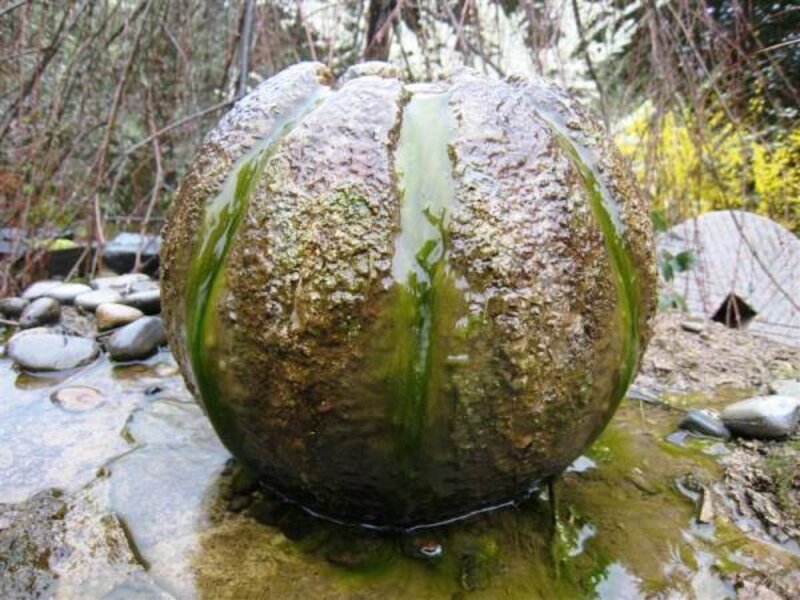Plants that fight algae in the water garden
Loading...
It must be spring – right now, my garden fountain is green with string algae. Yet I know that once my nitrogen-gobbling water plants wake up, the algae will diminish – without my removing any of it. If the specter of algae is casting its green sheen over your water feature, whether it’s a fountain or acres of pond, your first and best defense is to stock up on plants that can compete with the algae and win.
The nitrogen connection
Algae live on excess nitrogen in the water. This nitrogen comes from decomposing organic matter – everything from fish waste to falling leaves. Lower the amount of available nitrogen, and you will lower the amount of algae.
So the first step is to keep as much decomposing material out of the water. That’s why many homeowners put nets over their ponds in fall.
Of course, it helps to utilize the good bacteria in a biological filter, and to keep pools tidy. But fast-growing water plants are one of the best defenses against repeated algae blooms.
It’s the same principle you use in lawn care: If your grass is healthy and growing well, it won’t be overrun with weeds.
The green gap time
Before deciding which plants to introduce, here are a few cautions.
Algae will never go away entirely. Your water feature is not a swimming pool. Wherever you have sunlight, you will have algae. And in spring there’s always more of it. That’s because the good brown bacteria – the stuff that slimes your rocks – is busy breaking down organic matter and making more nitrogen available so that water plants can get a growing jump-start.
However, in cooler water temperatures – between 40 and 50 degrees F. (4 and 10 C) – the algae are the first to take advantage of all that extra nitrogen. That means algae can proliferate while your lovely plants just sit there.
But don’t worry. When temperatures rise higher, the plants that like the warmth outstrip the algae and claim the nitrogen for their own growth.
During this green gap time, you can skim out whatever algae is floating, but if you have the right ratio of plants to water surface, the plants can catch up and win the race.
Many experts like to see at least 40 percent of the water covered with plants by the end of the season. This holds true for both large and small water features. If you plant much more than that, you can end up with what one pond owner ruefully described as “a jungle in a bog.”
Plants to the rescue
While all pond flora get their nourishment from the water, some do a better job of sucking up nitrogen than others.
Iris, such as Iris ensata, I. versicolor, and the iris-like sweet flag (Acorus calamus) can compete with algae and also add structure and height.
Sedges – Carex riparia and Carex obnupta, Bowles golden grass (Carex elata ‘Aurea’) – and rushes like Juncus effusus and the smaller Juncus ensifolius bring color and movement to the water's edge.
Two more rushes, Typha minima and T. laxmannii, are elegant varieties that top out at two to four feet – a size welcome in many water arrangements.
As a rule, plants with larger leaf surfaces are heavier nitrogen feeders.
Consider water pickeral (Pontederia cordata) and arrowhead (Sagittaria sagittifolia). For luxuriant drama, try Colocasia esculenta ‘Black Magic’ and Canna ‘Cleopatra’.
Unfortunately, your beautiful waterlilies are plants you can’t count on to go into battle. Although they do discourage algae by shading the surface, they are the least effective when it comes to nitrogen uptake.
Invasiveness in water plants varies around the country. Always check your local regulations before adding new plants to your water garden.
Mary-Kate Mackey is one of nine garden writers who blog regularly at Diggin' It. She is co-author of “Sunset’s Secret Gardens — 153 Design Tips from the Pros” and contributor to the “Sunset Western Garden Book,” writes a monthly column for the Hartley Greenhouse webpage and numerous articles for Fine Gardening, Sunset, and other magazines. She teaches at the University of Oregon’s School of Journalism & Communication. She writes about water in the garden for Diggin’ It.
To read more by Mary-Kate, click here. The Diggin' It blog archive has everyone's posts (scroll down]. The Monitor’s main gardening page offers articles on many gardening topics. See also our RSS feed. You may want to visit Gardening With the Monitor on Flickr. If you join the group (it’s free), you can upload your garden photos and enter our next contest.





